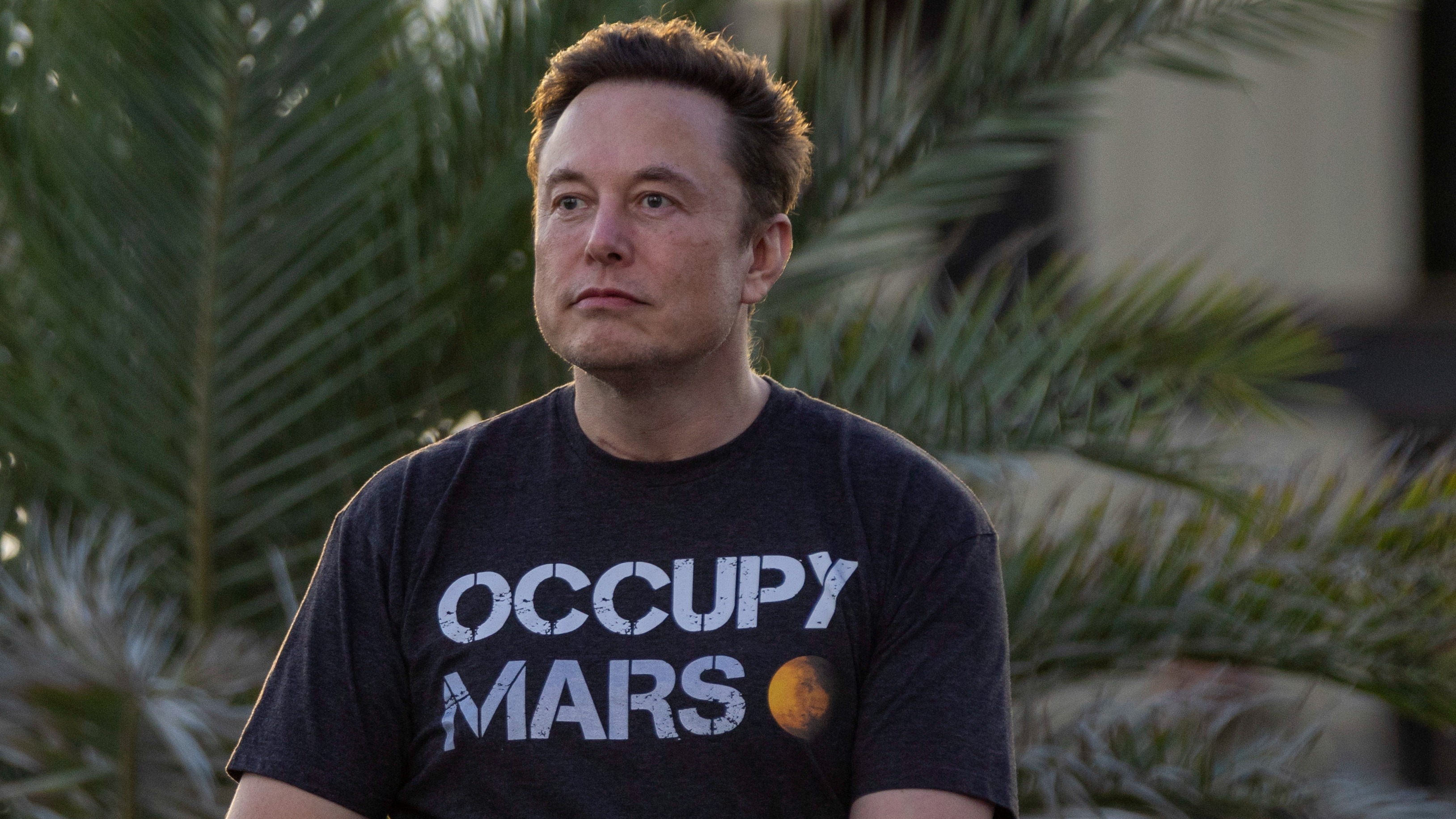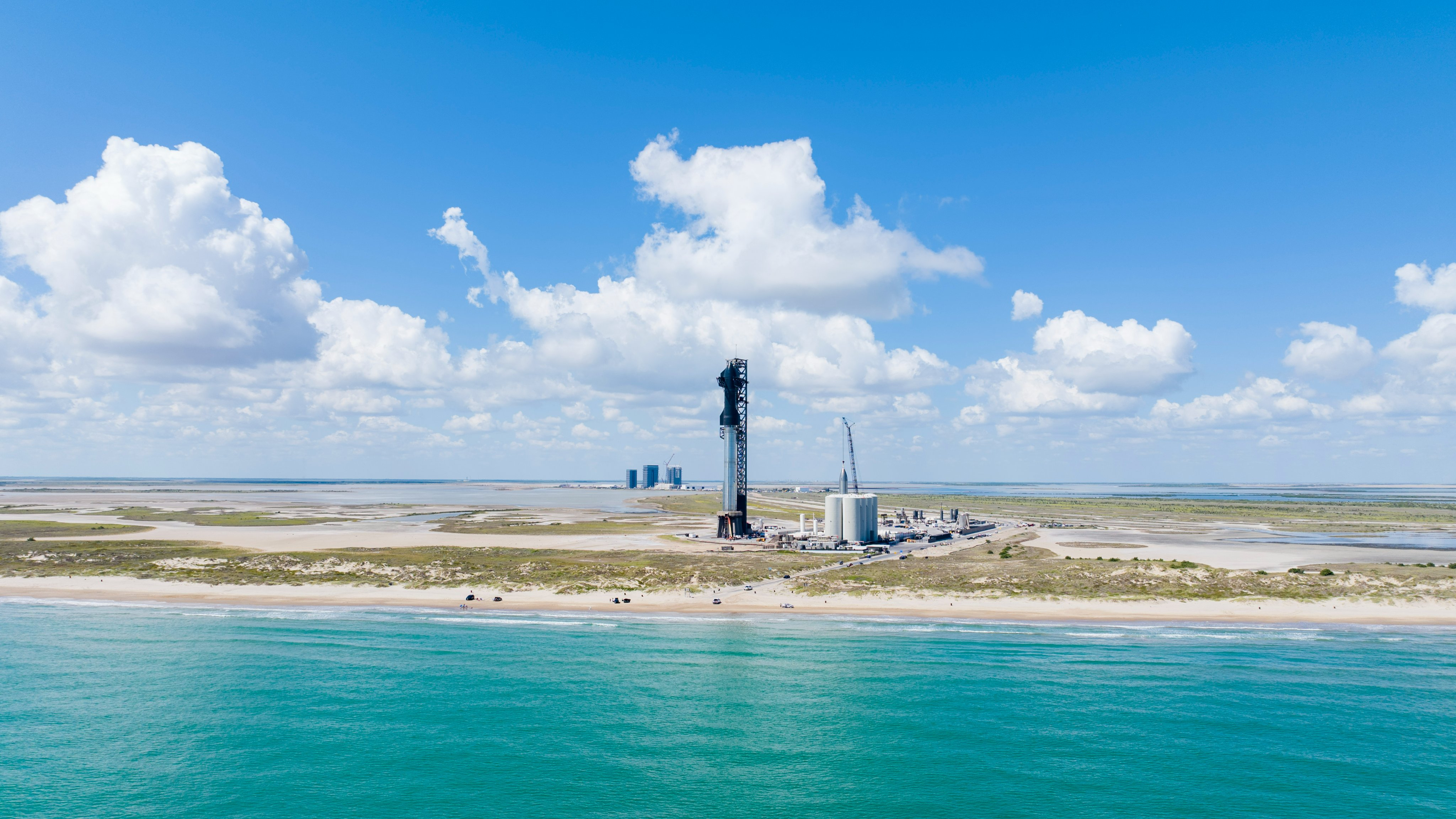SpaceX's Starship has 'decent chance' of success on upcoming flight, Elon Musk says
'If the engines light and the ship doesn't blow itself up … I think we've got a decent chance of reaching orbit.'

SpaceX CEO Elon Musk says he's hopeful Starship doesn't blow up on its second spaceflight attempt.
Elon Musk spoke about Starship, a huge SpaceX reusable rocket system aiming for a new near-orbital flight in the near future, in a keynote address on Thursday (Oct. 5) at the International Astronautical Congress (IAC) in Baku, Azerbaijan.
Speaking with moderator and Voyager Space chief revenue officer Clay Mowry, Musk said via video that SpaceX does not want to "set expectations too high" after an explosive orbital attempt in April. That effort saw Starship's two stages fail to separate, among other issues; SpaceX ultimately deliberately detonated the vehicle high above the Gulf of Mexico. Musk, 52, eventually hopes to use Starship to send people to the moon and Mars in line with his decades-long goal of reaching the Red Planet with SpaceX, which was founded in 2002.
Starship and its Super Heavy booster are the most powerful rocket system ever built, having nearly twice the liftoff thrust of NASA's Space Launch System (SLS) rocket designed for the Artemis program; SLS is the brawniest launcher currently in use until Starship is ready for operational flights.
A big contract deadline is coming, however: Starship has been tasked by NASA to land the Artemis 3 crew on the moon in 2025 or 2026 in the first such attempt by humans since Apollo 17 in 1972.
Related: SpaceX celebrated Starship's 1st launch. Some locals called it 'truly terrifying'
Delays in getting Starship ready in recent months caused NASA officials to say multiple times that they are keeping an eye on SpaceX's progress. Jim Free, the agency's associate administrator of the exploration systems development mission directorate, said in early August there is still time for SpaceX to meet NASA's Artemis 3 guidelines. But if not, he said, the agency is prepared to fly a non-landing mission for Artemis 3 and to delay the lunar touchdown to at least Artemis 4.
Breaking space news, the latest updates on rocket launches, skywatching events and more!
We don't know when Starship will fly again. Musk said in early May that the system would be ready for a new flight in "six to eight weeks". This summer, his company also did dramatic engine fires of Starship to prepare for the next flight. But the U.S. Federal Aviation Administration (FAA) cautioned in late September that the required regulatory processes for addressing issues on the first flight is not yet complete.
While SpaceX said it has implemented all 57 actions required for the next flight and completed its investigation, the FAA has not yet awarded a license for the second launch. SpaceX also needs to receive environmental approval from the U.S. Fish and Wildlife Service, according to Reuters. Once these key items are taken care of, however, SpaceX will likely launch quickly. Musk has also said that Starship is ready to go, from a technical standpoint.
Related: SpaceX's giant Starship vehicle towers above turquoise waters in gorgeous photo
Flight 2, as Musk calls the upcoming Starship launch, will include key changes SpaceX recently implemented to Starship. For example: The company aims to "hot stage" the system, meaning that Starship will light its second-stage engines before the vehicle's two stages have fully separated.
While the Soviet Union made use of hot staging before, Musk said it's the first time SpaceX will attempt it. "I'd say that's the riskiest part of the flight," he said. "If the engines light and the ship doesn't blow itself up during staging, then I think we've got a decent chance of reaching orbit."
Presuming that happens according to plan, Starship will make less than a complete orbit of Earth and splash down in the Pacific off the coast of Hawaii, he said. The next key test in-flight will be the heat shield, so far untested.
"We think it will work, but we aren't sure if it will work," Musk said of the heat shield. "So if it doesn't work, we want it to not work over the Pacific — which is a large body of water with almost no people on it."
Related: SpaceX to launch next Starship test flight 'soon,' Elon Musk says (photos)
The current version of Starship, Musk said, produces about twice the thrust of the powerful NASA Saturn V rocket that brought Apollo program astronauts to the moon in the 1960s and 1970s. "With the upgrades that we have in the works, it'll do about three times the thrust," he said. In real terms, Starship now produces 16 million pounds of thrust at liftoff, and SpaceX is aiming for 20 million pounds in the near term, after future engine upgrades.
More changes will also come with reusability, Musk said. Pending when licenses are granted, launch tower upgrades to the access arms to catch the returning Super Heavy booster's first stage from mid-air could be available "within the next year, or maybe less than a year." As for Starship itself: "If we get lucky, we might catch the ship towards the end of next year," Musk said.
The "absurd size" of the 394-foot-tall (120 meters) Starship and Super Heavy stack supports Musk's eventual crew destination: The Red Planet. The goal is "to build something that is capable of creating a permanent base on the moon, and a city on Mars. That's why it is so large. Otherwise we can make it much smaller," he said.
Musk is aiming for a Martian touchdown without a crew "within the next four years," although he cautioned the goal was only "sort of feasible." And there's more to come after that: The propulsion system of Starship "should, to generalize, be able to land anywhere on a solid surface anywhere in the solar system," Musk said.
Dust would present one of the biggest challenges for a moon landing, but assuming Starship can handle that, only "minor modifications" would be required for destinations such as Mars, the asteroid belt, and the icy moons of Jupiter and Saturn, Musk said. He added these far-flung destinations could host propellant plants to fuel future space exploration, using resources such as water ice.
The company is also looking to reuse other elements of its space systems as much as possible, including using its Earth-orbiting broadband satellite Starlink system for laser communications at Mars, as well as recycling elements of the SpaceX spacesuit in use for astronaut missions.
Currently the spacesuit is used for the interiors of spacecraft only, but upgrades (which Musk did not specify) will allow for an extravehicular activity or spacewalk outside Starship during the Polaris Dawn mission, the first of three flights in billionaire Jared Isaacman's self-directed space program. (Isaacman is paying for these missions, in addition to Inspiration4, which flew himself and three others on SpaceX's Falcon 9 and Crew Dragon in 2021.)
Then there's also lunar rovers, which could be modified from existing cars made by Tesla, Musk's car company. "The nice thing about electric cars is that they obviously do not require oxygen," said Musk, who is also founder and CEO of Tesla. "I think Tesla could easily make a car, like a Cybertruck 'luna variant.' Just get the IP [intellectual property] or get the 'moon option' package," he said.
SpaceX will generate revenue streams for Starship development through its other missions, including periodic Starlink launches (a version 3 is expected next year), its International Space Station launches of astronauts and cargo, satellite launches for customers such as the U.S. Space Force, and (Musk disclosed) an approximately 26-foot (8 m) space telescope for the University of California, Berkeley that may itself use Starship.
This revenue is not counting other crewed launches of Starship further in the future. Isaacman plans to conclude his three-mission Polaris Program with Starship, while other billionaires and space tourists such as Yusaku Maezawa and Dennis Tito plan separate moon ventures with the system.
Related: Meet the dearMoon crew of artists, athletes and a billionaire riding SpaceX's Starship to the moon
As these people launch in the future, Musk plans to implement frequent Starship sorties from both south Texas and from SpaceX's leased Launch Pad 39A at NASA's Kennedy Space Center in Florida where Crew Dragon launches already happen. Within four or five years, he predicted, it's possible SpaceX could have a "greenfield location" for Starship at nearby Cape Canaveral (where it already launches its Falcon 9 and Falcon Heavy rockets) capable of launching several times daily.
"Then we may need to go to an ocean-based platform, just if you're launching 10 times a day. That might be a bit much even for the Cape, I don't know," he continued. "But we may end up doing platform-based launches from a specially designed sort of oceangoing platform. But we will need to do a lot of launches. We're talking about thousands of launches per year."
Musk said the incredible launch rate would be necessary to send over 100,000 tons of cargo per year to orbit, which he said is "still not quite enough" for his dreams of Mars exploration that would require "roughly a million tons" per year. (For perspective, the workhorse Falcon 9 rocket sends about 1,500 to 1,600 tons to orbit per year, which Musk said is roughly 80% of Earth's annual launching mass to orbit. He hopes to boost that to 2,500 tons next year.)
"Either we do that, or we're a single-planet species forever," Musk said. "We achieve those kinds of numbers, or we will never have a self-sustaining city on Mars."
Those who remain on Earth could perhaps use Starship in other ways, Musk hinted, such as a fast way of moving people or cargo between continents on our planet, which he suggested may work out cost-wise as Starship uses low-cost liquid methane propellant. Further cost savings may be realized from eliminating pilots (as the system would be autonomous) and even items like bathrooms, given that passengers would only need half an hour on board to get to their destination.
"It really comes down to a question of, is it economically viable compared to long-distance aircraft? And I think our back-of-the envelope numbers suggest that it actually has a shot," he said.

Elizabeth Howell (she/her), Ph.D., was a staff writer in the spaceflight channel between 2022 and 2024 specializing in Canadian space news. She was contributing writer for Space.com for 10 years from 2012 to 2024. Elizabeth's reporting includes multiple exclusives with the White House, leading world coverage about a lost-and-found space tomato on the International Space Station, witnessing five human spaceflight launches on two continents, flying parabolic, working inside a spacesuit, and participating in a simulated Mars mission. Her latest book, "Why Am I Taller?" (ECW Press, 2022) is co-written with astronaut Dave Williams.


